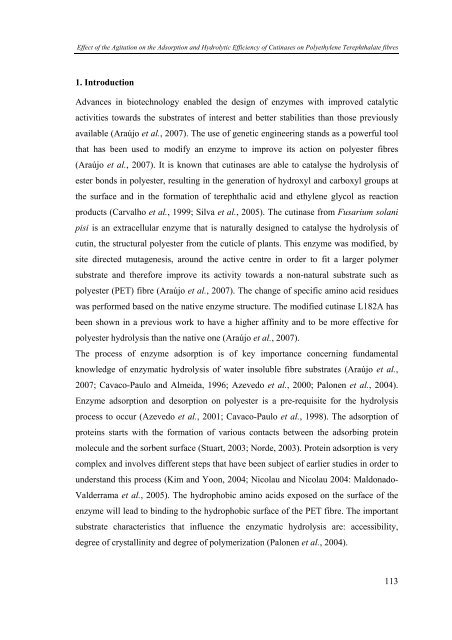Surface Modification of Cellulose Acetate with Cutinase and ...
Surface Modification of Cellulose Acetate with Cutinase and ...
Surface Modification of Cellulose Acetate with Cutinase and ...
Create successful ePaper yourself
Turn your PDF publications into a flip-book with our unique Google optimized e-Paper software.
Effect <strong>of</strong> the Agitation on the Adsorption <strong>and</strong> Hydrolytic Efficiency <strong>of</strong> <strong>Cutinase</strong>s on Polyethylene Terephthalate fibres<br />
1. Introduction<br />
Advances in biotechnology enabled the design <strong>of</strong> enzymes <strong>with</strong> improved catalytic<br />
activities towards the substrates <strong>of</strong> interest <strong>and</strong> better stabilities than those previously<br />
available (Araújo et al., 2007). The use <strong>of</strong> genetic engineering st<strong>and</strong>s as a powerful tool<br />
that has been used to modify an enzyme to improve its action on polyester fibres<br />
(Araújo et al., 2007). It is known that cutinases are able to catalyse the hydrolysis <strong>of</strong><br />
ester bonds in polyester, resulting in the generation <strong>of</strong> hydroxyl <strong>and</strong> carboxyl groups at<br />
the surface <strong>and</strong> in the formation <strong>of</strong> terephthalic acid <strong>and</strong> ethylene glycol as reaction<br />
products (Carvalho et al., 1999; Silva et al., 2005). The cutinase from Fusarium solani<br />
pisi is an extracellular enzyme that is naturally designed to catalyse the hydrolysis <strong>of</strong><br />
cutin, the structural polyester from the cuticle <strong>of</strong> plants. This enzyme was modified, by<br />
site directed mutagenesis, around the active centre in order to fit a larger polymer<br />
substrate <strong>and</strong> therefore improve its activity towards a non-natural substrate such as<br />
polyester (PET) fibre (Araújo et al., 2007). The change <strong>of</strong> specific amino acid residues<br />
was performed based on the native enzyme structure. The modified cutinase L182A has<br />
been shown in a previous work to have a higher affinity <strong>and</strong> to be more effective for<br />
polyester hydrolysis than the native one (Araújo et al., 2007).<br />
The process <strong>of</strong> enzyme adsorption is <strong>of</strong> key importance concerning fundamental<br />
knowledge <strong>of</strong> enzymatic hydrolysis <strong>of</strong> water insoluble fibre substrates (Araújo et al.,<br />
2007; Cavaco-Paulo <strong>and</strong> Almeida, 1996; Azevedo et al., 2000; Palonen et al., 2004).<br />
Enzyme adsorption <strong>and</strong> desorption on polyester is a pre-requisite for the hydrolysis<br />
process to occur (Azevedo et al., 2001; Cavaco-Paulo et al., 1998). The adsorption <strong>of</strong><br />
proteins starts <strong>with</strong> the formation <strong>of</strong> various contacts between the adsorbing protein<br />
molecule <strong>and</strong> the sorbent surface (Stuart, 2003; Norde, 2003). Protein adsorption is very<br />
complex <strong>and</strong> involves different steps that have been subject <strong>of</strong> earlier studies in order to<br />
underst<strong>and</strong> this process (Kim <strong>and</strong> Yoon, 2004; Nicolau <strong>and</strong> Nicolau 2004: Maldonado-<br />
Valderrama et al., 2005). The hydrophobic amino acids exposed on the surface <strong>of</strong> the<br />
enzyme will lead to binding to the hydrophobic surface <strong>of</strong> the PET fibre. The important<br />
substrate characteristics that influence the enzymatic hydrolysis are: accessibility,<br />
degree <strong>of</strong> crystallinity <strong>and</strong> degree <strong>of</strong> polymerization (Palonen et al., 2004).<br />
113

















